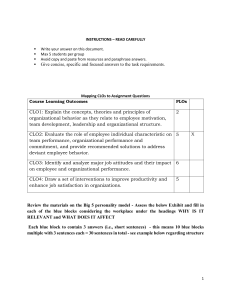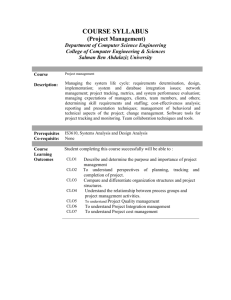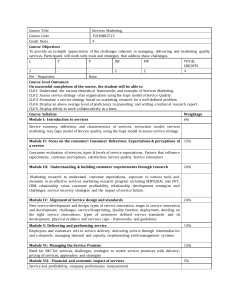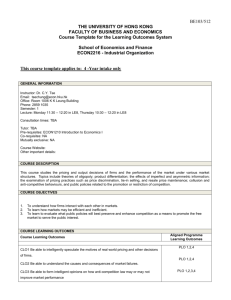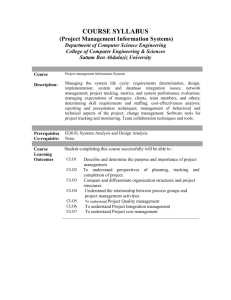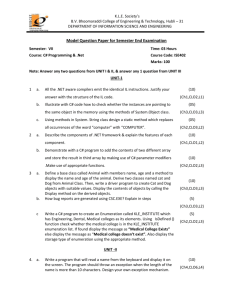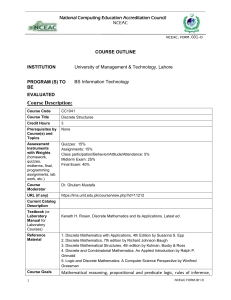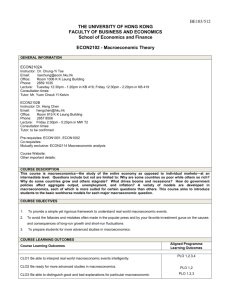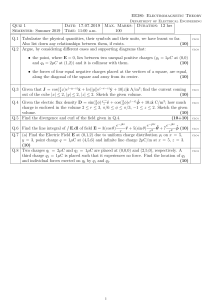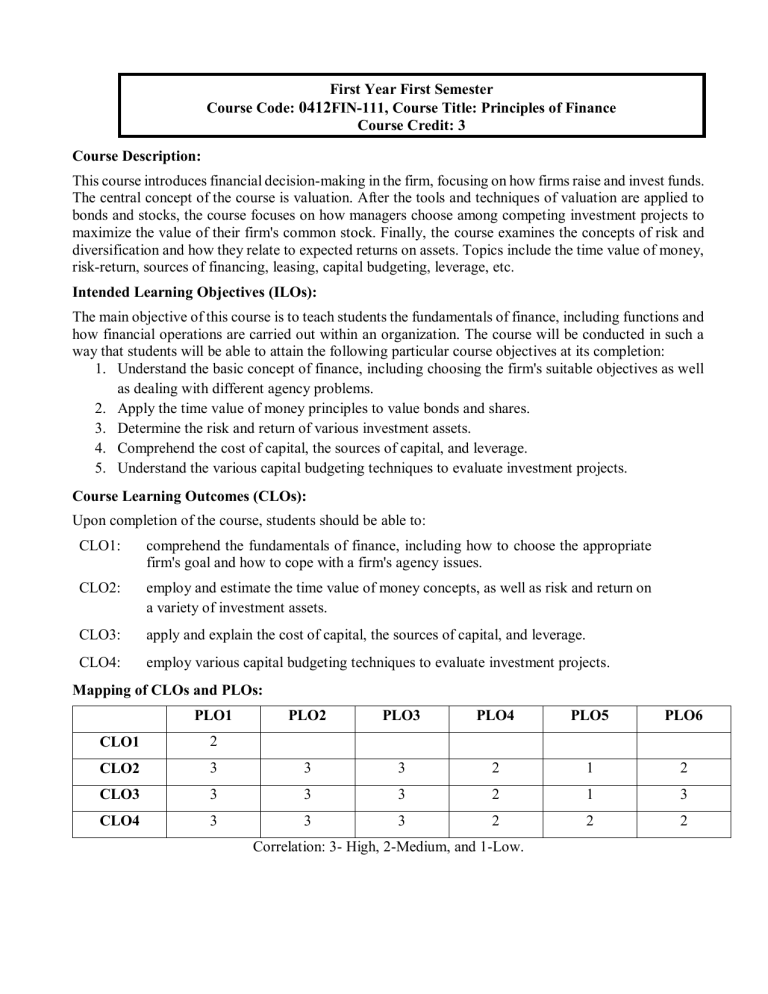
First Year First Semester Course Code: 0412FIN-111, Course Title: Principles of Finance Course Credit: 3 Course Description: This course introduces financial decision-making in the firm, focusing on how firms raise and invest funds. The central concept of the course is valuation. After the tools and techniques of valuation are applied to bonds and stocks, the course focuses on how managers choose among competing investment projects to maximize the value of their firm's common stock. Finally, the course examines the concepts of risk and diversification and how they relate to expected returns on assets. Topics include the time value of money, risk-return, sources of financing, leasing, capital budgeting, leverage, etc. Intended Learning Objectives (ILOs): The main objective of this course is to teach students the fundamentals of finance, including functions and how financial operations are carried out within an organization. The course will be conducted in such a way that students will be able to attain the following particular course objectives at its completion: 1. Understand the basic concept of finance, including choosing the firm's suitable objectives as well as dealing with different agency problems. 2. Apply the time value of money principles to value bonds and shares. 3. Determine the risk and return of various investment assets. 4. Comprehend the cost of capital, the sources of capital, and leverage. 5. Understand the various capital budgeting techniques to evaluate investment projects. Course Learning Outcomes (CLOs): Upon completion of the course, students should be able to: CLO1: comprehend the fundamentals of finance, including how to choose the appropriate firm's goal and how to cope with a firm's agency issues. CLO2: employ and estimate the time value of money concepts, as well as risk and return on a variety of investment assets. CLO3: apply and explain the cost of capital, the sources of capital, and leverage. CLO4: employ various capital budgeting techniques to evaluate investment projects. Mapping of CLOs and PLOs: PLO1 PLO2 PLO3 PLO4 PLO5 PLO6 CLO1 2 CLO2 3 3 3 2 1 2 CLO3 3 3 3 2 1 3 CLO4 3 3 3 2 2 2 Correlation: 3- High, 2-Medium, and 1-Low. Sl No. Course Contents Hours CLOs Teachinglearning strategy 1 Introduction: Conceptual Framework, definition of Finance, Financial Decision making, Role of Finance in a firm, Goal of financial management of a firm, Finance as a discipline, and agency problems of a firm. 6 CLO1 Lectures 2 Time Value of Money: Basic concepts, computing present values, future values. 6 CLO2 Lectures, exercise 3 Risk and Return: Financial and Business risk, leverage, and risk. Measuring risk; probability distribution. Expected value, Standard deviation, and coefficient of variation. Risk premium, Risk, and required rate of return. 7 CLO2 Lectures, exercise 4 Sources of Financing: Short-term, long-term loans. General characteristics of financing method-Debt, Preferred stock, Common stock, and Returned earnings. Raising funds from the capital market. Institutions supplying long-term Finance in Bangladesh. 6 CLO3 Lectures, exercise 5 Leasing: Basic concepts, types of leases, Lease or buy decision. 6 CLO3 Lectures, exercise 6 Capital Budgeting: Basic concepts. The capital budgeting process, cash flow from an investment. Introduction to the evaluation techniques: Traditional and Discounted cash flow methods. 8 CLO4 Lectures, exercise 7 Leverage: Basic concept, types of leverage, DOL, DFL, and DTL. 6 CLO3 Lectures, exercise Essential Learning Materials: 1. Bresley and Bingham, Financial Management 2. Gitman, L. J.: Principles of Managerial Finance 3. Weston, J.F. and Bingham, E.F.: Managerial Finance 4. Schall, L. D.& Haley, C. W.: Introduction to Financial Management Course Code: 0412FIN-112, Course Title: Introduction to Business Course Credit: 3 Course Description: This course affords students an understanding of business organizations' basics, nature, structure, and functions. You also get an experience of how a corporation is incorporated. This course also covers entrepreneurship, SMEs, other business formslike joint-venture companies, MNCs, franchising, and business combinationsocial responsibility and business ethics. With the mix of lectures, tutorials, and assignments, the course aims simultaneously to cater to the needs of those who have not formally studied the subject. Intended Learning Objectives (ILOs): The core objective of offering this course is to make students understand the basics of the business environment, the functions of modern business enterprises, and their social responsibility and ethics. The course will be taught in such a way that students will be able to attain the following particular course objectives at its completion: 1. 2. 3. 4. 5. Expose the interested students to many functions of modern business enterprises. Understand entrepreneurship and SMEs. Present a general background in the elements and characteristics of business enterprise Expose the students to the multitude of career fields in business. The students of the Department will be able to learn about the business environment and how business works in a holistic manner. Course Learning Outcomes (CLOs): Upon completion of the course, students should be able to: CLO1: identify the background of the business along with the characteristics, elements, and environment of the business. CLO2: demonstrate knowledge of the general business environment, business systems, business forms, entrepreneurship, SME, company incorporation, constitutions, and the corporation's management. CLO3: demonstrate knowledge of other business forms, social responsibility, and business ethics. CLO4: demonstrate the course's knowledge, including exploring career options and developing business problem-solving skills. Mapping of CLOs and PLOs: PLO1 PLO2 PLO3 PLO4 PLO5 CLO1 2 3 CLO2 3 3 CLO3 1 3 CLO4 1 2 PLO6 Correlation: 3- High, 2-Medium, and 1-Low. Sl No Course Contents Hours CLOs Teachinglearning strategy 1 Basics of Business: Concept of business, business objectives, characteristics of a free enterprise system, economic system, characteristics of the business, components of the business: industry, commerce, and trade. 7 CLO1 Lectures, exercise 2 3 4 Entrepreneurship and SME: Entrepreneurship, franchising, small business, entrepreneur or businessman, qualities of a successful businessman, requisites of a successful businessman, entrepreneurship development cycle, small business, business plan. 6 Forms of Legal Ownership: Factors affecting organization choice, Sole Proprietorship Business – meaning, leading features and advantages, small business. Partnership Business – characteristics, legal implications, partnership deed, evaluation of partnership Business. Company form of Business – range of a corporation’s relationship, features, types of corporations, and favorable characteristics of a corporation. 7 Other forms of business: joint venture, multinational companies, franchising, business combination and integration, and network marketing 7 CLO2 Lectures, exercises, open discussion CLO2 Lectures, exercises, Open discussion, Debates CLO3 Lectures, exercises, Open discussion, Debates 5 Incorporation of a company: corporation, its process, registration, constitutions of a company: Memorandum of Association, Articles of association, AGM, annual reports, statutory meeting, prospectus, 7 CLO2 Lectures, exercise 6 Social responsibility and Business ethics: Social responsibility, Responsibility to the customer, employees, responsibility to the environment, Business ethics – factors influencing ethical behavior 6 CLO3 Lectures, exercises, Open discussion, Debates 7 Location of Business: Selecting a suitable location for a business, factors of location that should be considered to start a business. Essential Learning Materials: 1. M.C. Shukla, Business Organisation and Management 2. U. C. Shukla: Business Organization & Management 3. Perlick and Lesikar: Introduction to Business. 4. Richard Norman Ownes: Business Organization & Combination 5. May and Baker: Introduction Business 5 CLO2 Lectures, exercise Course Code: 0412GED-113, Course Title: Statistics for Business-I Course Credit: 3 Course Description: In today's world, good decision-making relies on data and data analysis. This course helps students develop the understanding that they will need to make informed decisions using data and communicate the results effectively. The course is an introduction to the essential concepts, tools, and methods of statistics for students in business, although it may have a broader interest. Topics cover data collection and presentation, measures of central tendency, measures of dispersion, moments, skewness and kurtosis, correlation and regression, probability and probability distribution, sampling and sampling distribution, the test of hypothesis, the test of goodness of fit, index number, time series, analysis and practical application of the statistical concept in business. Intended Learning Objectives (ILOs): This course primarily intends to enhance students' knowledge of statistical concepts, which encompasses data collection, central tendency, dispersion, correlation analysis, and regression. However, the students will be able to attain the following particular course objectives at its completion: 1. Students will be able to understand the concept of business statistics which helps them study other business-oriented courses. 2. Students will comprehend to create the guidelines for statistical methods used in the day-to-day activities of a business in both written work and oral attendance. 3. Students will be able to learn a lot of statistical tools and techniques to determine product qualities and performances. 4. Students will gain an understanding through necessary and effective statistical methods to make fruitful decisions in business. Course Learning Outcomes (CLOs): Upon completion of this course, students should be able to: CLO1: CLO2: gather knowledge on statistical concepts, including basic concepts, data collection, presentation, central tendency measurements, dispersion, regression, and correlation analysis. learn to perform things like calculating and applying location measures and measures of dispersion-grouped and ungrouped data cases. CLO3: learn to perform things like computing moments from arbitrary value-moments from meanrelation between moments-measures of skewness and kurtosis and their uses. CLO4: learn to perform things like computing and interpreting the results of bivariate regression and correlation analysis for forecasting. Mapping of CLOs and PLOs: PLO1 CLO1 CLO2 CLO3 CLO4 3 3 3 PLO2 1 3 3 3 PLO3 PLO4 2 2 2 2 2 3 PLO5 PLO6 Sl No. Correlation: 3- High, 2-Medium, and 1-Low. Course Contents Hours CLOs Teaching-learning strategy 1 Introduction: Definition, nature, scope, functions, limitations, uses, and misuses of statistics in Business. 6 CLO1 Lecture, exercise, and two-way interactions 2 Data Collection and Presentation: Collection, classification & tabulation of statistical data-frequency distribution and graphical representation of data. 6 CLO1 Lecture, exercise, and two-way interactions 3 Measures of Central Tendency: Mean Median & Modetheir computation and properties, problems. 7 CLO2 Lecture, exercise, and two-way interactions 4 Measures of Dispersion: Absolute and relative measures of dispersion, computation, and properties, application in business problems. 6 CLO2 Lecture, exercise, and two-way interactions 5 Skewness, Moments, and Kurtosis: Moments from arbitrary value-moments from mean-relation between moments-measures of skewness& kurtosis and their uses. 6 CLO3 Lecture, exercise, and two-way interactions 6 Correlation Analysis: Meaning, significance, types and methods of correlation, Karl Pearson’s coefficient of correlation, Rank correlation coefficient, and uses. 7 CLO4 Lecture, exercise, and two-way interactions 7 Regression: Meaning; The linear Bivariate Regression Model, Regression lines, Regression equation, Regression coefficient, Bivariate grouped frequency distribution, Standard error in the estimate, Relation between correlation and regression, and uses of correlation and regression. 7 CLO4 Lecture, exercise, and two-way interactions Essential Learning Materials: 1. Business Statistics by Gupta, S.P. and Gupta, M.P. 2. Richard Levin: Statistics for Management 3. Mia, M. A., and Mayan, A.: Introduction to statistics 4. Shukla, M. C., and Gulshan, S. S.: Statistics theory and practice 5. Buddington, A. L.: Statistics and their application in commerce Course Code: 0412GED-114, Course Title: Basic English Course Credit: 3 Course Description: Flawless communication in the English language is an imperative asset in today’s competitive world. Thus, this course is included in the curriculum with materials relating to the knowledge of basic English and understanding its basic structures. It will benefit students from different academic backgrounds with no major in English. Furthermore, it will improve the students’ reading, writing, speaking, and listening skills to comprehend correct English grammar better and make communication easier, clearer, and more efficient. Intended Learning Objectives (ILOs): This course primarily intends to make students able to enhance the four basic skills of English: reading, writing, speaking, and listening. However, the students will be able to attain the following particular course objectives at its completion: 1. To make students revise and strengthen the most significant basic structures in English grammar to build a strong foundation. 2. To enable students to recognize and understand the meaning of targeted grammatical structures on all four English language forms. 3. Students will be able to read analytically. 4. Students will acquire the ability to think critically and logically. 5. To enable the students to use the language for free-hand writing with confidence using proper techniques and styles. 6. To enhance the student’s speaking skills through conversational learning, self-assessment, and remedial work with the lecturer. Course Learning Outcomes (CLOs): Upon completion of this course, students should be able to: CLO1: apply the conceptual knowledge of the English language in reading, writing, and speaking with thinking critically and logically to explain their academic terms in English. CLO2: form sentences with the correct grammatical application in both oral and written. CLO3: read the academic contents with proper understanding, which helps students conduct high-quality reports, presentations, and papers within a variety of work environments CLO4: analyze and comment on recent business issues in English related to their academics, as well as do well in several job sectors. Mapping of CLOs and PLOs: PLO1 PLO2 PLO3 PLO4 PLO5 CLO1 2 2 CLO2 1 2 CLO3 1 2 CLO4 2 2 PLO6 Correlation: 3- High, 2-Medium, and 1-Low. Sl No. Course Contents Hours CLOs Teachinglearning strategy 1 Basic Grammar: parts of speech (detailed application); basic sentence patterns (including degrees); phrases, clauses, and their structures; Subject-verb agreement; right forms of verbs; changing the forms of speech; transformation of sentences; uses of modals in conditional sentences. 10 CLO1 Lecture 2 Reading: understand reading strategies (skimming, scanning, predicting, inference, intensive and extensive reading, etc.); improve linguistic skills and expand vocabulary; recognize and understand the main idea and supporting details of the passages of a text; use strategies to ascertain meaning from unfamiliar vocabulary encountered in context; increase reading rate; understand a writer’s tone, mode, and purpose. Writing: writing a personal email/formal letter to English-speaking companies or departments. Write job application/ prepare resume/C.V. paragraph, essay, report, or article writing; write letters about events and personal experiences; write summaries and reviews of business terms and decisions or business case studies; writing activities through picture stories (maps, graphs, diagrams, and so on). Speaking: recognize and use internationally-used English language greetings and introductions (introduction, interests, aims, daily routine); communicate with English-speaking employers in a job interview; Speak fluently using basic and moderately complex sentence structures; use appropriate verbal syllable, intonation, stress, and rhythm; engage in verbal roleplaying in formal and informal situations; express advice and personal opinions with supporting information; paraphrase stories and information; make formal and informal oral presentations; understand and application of phrasal expression. 8 CLO1 Lecture, Exercise, Open Discussion 10 CLO1,2,3 Lecture, Exercise, Open Discussion 10 CLO1,2 Lecture, Exercise, Open Discussion 3 4 5 Across Multiple Language Domains: Acquire and use new academic vocabulary and application; demonstrate at-level understanding of grammar in speaking and writing; understand inconsistencies among punctuation, pronunciation, and spelling. Accurately compose moderately complex sentences with basic transitions to connect ideas in spoken and written discourse; identity written and spoken language patterns, 7 CLO1,2,4 Lecture, Exercise, Open Discussion including sequential events, cause, effect, compare and contrast, and problem/solution narratives. Essential Learning Materials: 1. 2. 3. 4. 5. 6. 7. A Practical English Grammar by A.J. Thomson & A.V. Martinet High School English Grammar and Composition by P.C. Wren & H. Martin Practical English Usage by Micheal Swan Applied English grammar and composition by P.C. Das Barron’s TOEFL by Pamala J. Sharpe Cliffs TOEFL Preparation Guide by Michael A. Pyle and Mary Ellen Munoz Page Texts include print and online versions of newspapers, brochures, course catalogs, campus maps, internet-based communication platforms, etc. Course Code: 0412GED-115, Course Title: Computer in Business and Management Information System Course Credit: 3 Course Description: This course introduces the concepts of computers, their components, computer number systems, software components, information systems, and their application in the real world. The course encompasses the basic ideology of computers, computer systems, computer codes and arithmetic, software and hardware, system units, data processing through using compute, various applications software related to Business, organizational and managerial foundations of systems, the technical foundation for understanding information systems, the role of information systems in enhancing business processes and management decision making across the enterprise, and the process of building and managing systems in organizations. Intended Learning Objectives (ILOs): This course primarily intends to make students understand computers and information technology and their roles in business. Nonetheless, the students will be able to attain the following particular course objectives at its completion: 1. To describe the role of information technology and decision support systems in business and record the firm's current issues to solve business problems. 2. To provide students with extensive knowledge and technical skills in computer-based information systems analysis and design and develop an understanding of the principles and techniques used. 3. To enable students to understand the various knowledge representation methods and different expert system structures. 4. To enable the students to use the information to assess the internet's and internet technology's impact on electronic commerce and business and understand computer systems' specific threats and vulnerabilities. 5. To provide the theoretical models used in database management systems to solve business problems. Course Learning Outcomes (CLOs): Upon completion of the course, students should be able to: CLO1: Understand computers, their components, computer number systems, software components, information systems, and their application in the real world. CLO2: use the basic ideology of computer, computer system, computer codes and arithmetic, software and hardware, system units, data processing, and application packages. CLO3: use of various applications software related to business, organizational, and managerial foundations of systems, the technical foundation for understanding information systems, the role of information systems in enhancing business processes and management decisionmaking across the enterprise CLO4: use of strategic information systems, ethics in information systems, and information system control, along with the process of building and managing systems in organizations. Mapping of CLOs and PLOs: CLO1 CLO2 CLO3 CLO4 PLO1 1 3 2 2 PLO2 PLO3 PLO4 PLO5 PLO6 2 1 1 1 1 Correlation: 3- High, 2-Medium, and 1-Low. Sl No Course Contents Hours CLOs Teachinglearning strategy 1 Introduction to Computer: Definition and Types, Generation and development of computer, Advantages and disadvantages of computer, Role of computer in business. 5 CLO1 Lecture, exercise 2 Basics of Computer: Components-CPU-Input devices-Output devices-Advantages and disadvantages of computerization-Effects of computers in Business, components of computer system, BinaryOctal-Hexadecimal-Number system-Conversion of number systems, Concepts of computer system; Computer hardware; Computer software; Telecommunications and networks. 5 CLO1 Lecture, exercise 3 Data Processing: Meaning of information; Data vs. information; Purpose of data processing-Operation structure-Concepts-Modern techniques. 5 CLO2 Lecture, exercise 4 Application of Packages: Introduction to WINDOWS; MS Word; Excel; MS-PowerPoint; MS Access. Financial Accounting Application in MS-Excel, CRM Application in MS-Access. Financial Analysis and Planning Templates in MS Excel, Bulk Mailing Applications in MS Word, and Building Business Presentation in MS PowerPoint. 5 CLO2, 3 Lecture, exercise 5 Information System: Necessity of information system; Information system and organization structure. 5 CLO4 Lecture, exercise 6 Information System for Managerial Decision Making: Introduction; Transaction processing system; Management information system; Decision support system. 5 CLO4 Lecture, exercise 7 Business Applications of Information System: Decision support system; Executive information system; Critical success factors for decision support system and executive support system. 5 CLO4 Lecture, exercise 8 Strategic Information System: Definition, Characteristics; Strategies for developing a strategic information system. 3 CLO4 Lecture, exercise 9 Ethics in Information System. 3 CLO4 Lecture, exercise 10 Controlling Information System: System vulnerability and abuse; Creating a controlled environment; Auditing information system. 4 CLO4 Lecture, exercise Essential Learning Materials: 1. Davis, G.B. and Olsan, M.H.: MIS – Conceptual Foundations, Structure ad Development, McGraw Hill International Edition 2. Landon, K.C., and Lauden, L.J.: MIS – Organization and Technology, Prentice Hall 3. William S. Davis: Computers and Business Information Processing. 4. Sanders D. Donald: Introduction to Information Processing. 5. S. E. Hutchinson and S. C. Sawyer: Computers and Information System. Course Code: 0412FIN-116, Course Title: Finance Lab-I Course Credit: 1.50 Course Description: Finance Lab-I is an introductory course designed to provide students with practical knowledge of basic computer, business communications, and basic statistics. The course aims to equip students with a foundation in computer skills, business communication, and basic statistical analysis, which will be useful in the finance industry. The course will be taught through a combination of lectures, workshops, and practical sessions to ensure students gain hands-on experience. Intended Learning Objectives (ILOs): 1. To provide students with hands-on experience in computer basics, including how to use basic software applications (e.g., MS Word, Excel, PowerPoint, etc.) and manage files and folders. 2. To develop students' proficiency in basic business communications, including email etiquette, report writing, and effective presentations. 3. To provide students with an understanding of basic statistical concepts and techniques, including descriptive statistics, probability distributions, ANOVA, regression, and index numbers. 4. Enhance critical thinking and problem-solving skills through hands-on exercises and case studies. Course Learning Outcomes (CLOs): Upon completion of the course, students should be able to: CLO1: Acquire basic knowledge of computer applications such as Microsoft Office to support financial analysis in the business. CLO2: Develop an understanding of business communications basics, including email, report writing, and presentation skills for effective communication. CLO3: Apply basic statistical techniques (e.g., descriptive statistics, data analysis, and visualization) to analyze and interpret data. CLO4: Enhance critical thinking and problem-solving skills through hands-on experiences and apply them to real-world business scenarios. Mapping of CLOs and PLOs: PLO1 CLO1 PLO2 PLO3 3 2 PLO4 PLO5 1 CLO2 CLO3 CLO4 PLO6 3 2 2 3 Correlation: 3- High, 2-Medium, and 1-Low. Sl No. Course Contents Hours CLOs Teachinglearning strategy 1 Computer hardware and application software: The basic building block of computer hardware and software, how to search, email, open server, save files, send prints on server printer, etc. Microsoft Office: MS Word, Excel, PowerPoint, etc.) 2 CLO1 Lectures, practice 3 CLO1 Lectures, practice 3 Formal presentation, use of different options like transition, animation, etc., using Microsoft PowerPoint. 2 CLO1,2 Lectures, practice 4 2 CLO3 5 Introduction to Flow Chart Designing: Create block diagrams and flow charts. Writing of Resume/CV/Biodata, Cover letter, and Email, 4 CLO2 6 Report writing and LATEX 2 CLO2 7 Bank statements and result sheet 2 CLO4 8 Presentation of data (Tabulation, graphs, etc.) 2 CLO3 9 Basic statistics: Mean median, mode, standard deviation, correlation, ANOVA, regression, and index numbers. 4 CLO3,4 Lectures, practice Lectures, practice Lectures, practice Lectures, practice Lectures, practice Lectures, practice 2 Essential Learning Materials: 1. The course teachers will provide materials.
